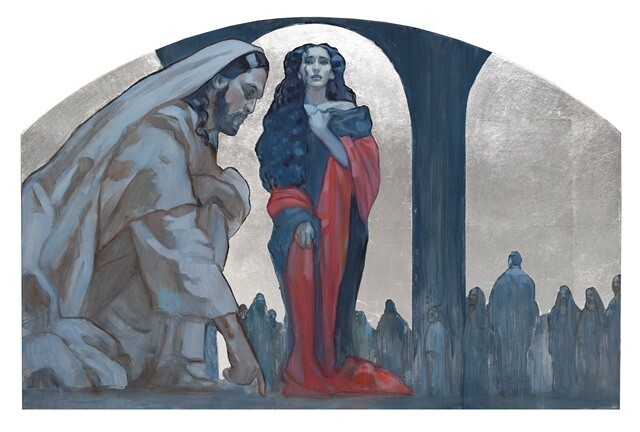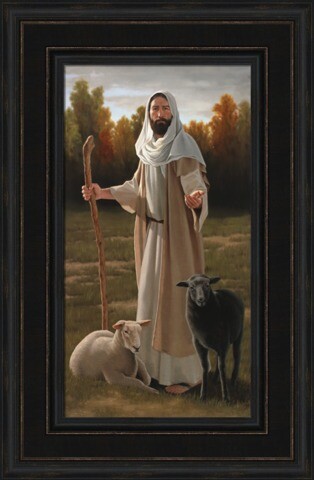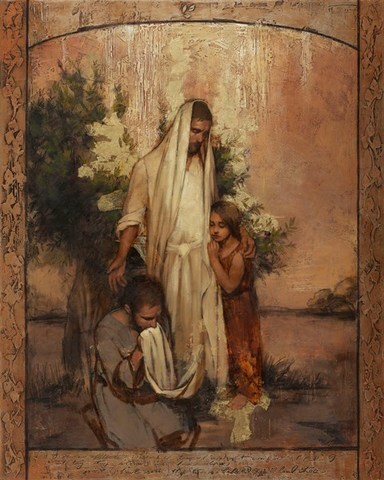Lds Pictures of the Savior Lds Art Greg Olsen
Of all the subjects to paint or draw, at that place are possibly none weightier than Jesus Christ, the Lord Almighty. Never before has there existed a existence as complex as He—who encompasses the complete spectrum of divinity and mortality. He is an advocate and gauge, king and servant, brother and friend. He is an advocate and judge, male monarch and servant, blood brother and friend. He has created countless worlds and has counted each of His creations—even the sparrows. But there are those who take taken on the challenge of depicting the Messiah, including these vii Latter-mean solar day Saint artists. Drawing from their personal relationships with Him, they create artwork that touches hearts and brings others closer to their Savior. Here are their insights.
Greg Olsen
"Somehow, through Him, I see myself differently, I come across those around me differently, and I come across His light in other people and in the world around me," Greg Olsen says of his feel painting the Savior, Jesus Christ.
"Role of Jesus'due south mission was to be a template to show us what was possible in our own lives—to reveal the divinity in each of u.s.," Olsen explains. He adds that as the Savior went about His ministry building, "He was so frequently revealing the divinity in those effectually Him and showing us how we should view the world and how we should encounter ourselves."
Olsen captures this higher perspective in his painting, Even a Sparrow.To the artist, this painting changes the way he thinks about God's creations. "We actually are connected," Olsen says. "We all have life considering of the light of Christ. That's what permeates all of us; that'due south what gives us jiff; that's what gives us life. And that's in these little sparrows, and somehow that connectivity gives [the Savior] the capacity to exist aware, to be loving, to be concerned near fifty-fifty a niggling sparrow. Every i of us ought to feel assured that He's continued with you lot and me, that He'south enlightened, that He loves us, that there'southward nothing going on in our lives that He is not enlightened of and interested in."
Observe more from Greg Olsen on deseretbook.com.
Liz Lemon Swindle
Image courtesy of Liz Lemon Swindle
It has taken popular religious artist Liz Lemon Swindle time to discover peace with her ability to paint Jesus Christ. "In the first, I wrestled with all kinds of incertitude," she shares. "I would hear some criticism and go into a deep funk. I would compare myself to other artists in the community and feel similar I was coming up short." She continues, "I feel the responsibility I and other artists carry. The images nosotros create will bear upon generations. Some people class their personal paradigm of Jesus based partly on what our paintings portray. That is a sobering reality."
That being said, Swindle also recognizes that "you have to appreciate your talent and trust information technology. When I started [painting Christ], I was adamant to pigment the universal Christ. I would run myself ragged trying to please everybody. So I finally realized that my opinion mattered to my Heavenly Begetter—that I wasn't given this talent to stand for everyone else's idea of who Christ is. That's when I could start painting from my heart and my spirit, because I remember our individual spirits have enormous capacity to do more if we volition let them."
Equally Swindle has continued to paint her Savior, her love and understanding of her role as an artist have grown. She shares, "The commencement thing I run into every morning when I open the door to my studio are the paintings of Jesus on my easels. The room is serenity, peaceful, and condom, as if someone has stood baby-sit over information technology while I was away. I say that because every night before I go habitation, I ask Heavenly Father to protect [this infinite]."
Swindle had a turning bespeak in career and discipleship as she kept runway of the special experiences with her Savior that came through her art. "I realized my relationship with Jesus Christ started to change from artist to friend when I wanted to keep those [sacred] feelings close to my heart, non broadcasting them casually. There are experiences I love to share—the trick is knowing what not to share."
She concludes, "I am the only ane qualified to portray my image of Jesus Christ. No 1 tin can do that for me and I can't exercise that for anyone else. My hope is that what I create will spark others' thoughts on Jesus, giving them the opportunity to begin and nurture their own human relationship with Him."
Discover more than from Liz Lemon Swindle on deseretbook.com.
Dan Wilson
Paradigm courtesy of Dan Wilson
At the beginning of his creative career, Dan Wilson concentrated primarily on the technical execution of painting and less on the emotional pull. "I was merely painting whatsoever," says Wilson, "and it was all about being 100 pct correct in shapes, values, edges, color." That inverse the commencement fourth dimension he attempted to paint the Savior.
"Information technology was honestly probably one of the first paintings that I put a lot of my emotion into," Wilson says. Just he didn't stop there. Every bit he connected to endeavour his hand at painting the Savior and distributed the finished products to friends and neighbors, Wilson recognized the bear upon that these paintings had on their viewers. "The Spirit hit me really strong at that point," Wilson says, "and I knew that I'm not supposed to paint only to paint, merely I'm supposed to be uplifting people with images that tin remind [them] of their discipleship, their beliefs—that can remind them of the reasons why they're living."
However, Wilson is quick to bespeak out that painting with emotion doesn't hateful he has sacrificed the technical aspects from his training. "When I paint Him, I desire to do Him justice; I want to exercise the all-time that I maybe can," he says. As Wilson has worked to interweave emotion and technique, he feels his paintings have come alive. One time, while painting a portrait of the Savior in a crown of thorns, Wilson was checking the details. He recalls, "I was critiquing myself, and once I backed up and I was looking at my painting, and all of a sudden I didn't feel like the artist critiquing myself whatsoever more. I felt similar I was looking at the Savior. And I merely felt the Spirit bearing testimony to me that He actually did wear that crown of thorns; He really did [perform] all those miracles that are spoken of in the Bible; He really did pay the result of my sins. He really did die and take out death." And though intense spiritual experiences don't happen every fourth dimension Wilson paints, he says, "when information technology does happen, it makes information technology all worth it. And hopefully, that is an experience that the viewers can go out of viewing my painting."
Rose Datoc Dall

Image courtesy of Rose Datoc Dall
Rose Datoc Dall sees Christ in the "in-betwixt moments"—the moments just before and after a major event, the moments in which we can meet sides of the Savior and His ministry that we otherwise would not run into.
"Most of our lives are built upwardly of ordinary moments, not all amazing events," Dall says, explaining her fascination with the small moments. She has found that in the bounding main of New Testament paintings, it is often the major events in the Savior's life that are portrayed. And although she recognizes that those events are certainly worthy of depicting, she fears that they accept become commonplace. "I approach [traditional scenes] with a mixture of hesitation and trepidation," Dall says, "because there are a lot of paintings out there. Nosotros see [an image of Christ], we know what it's nearly, and we just miss [its significance]. So what I try to bring to it is a fresh perspective." In Dall's opinion, this fresh perspective should add something personal and genuine and do more than acknowledge the occurrence of an outcome.
In her painting Where Are Those Thine Accusers?(pictured higher up), Dall depicts the familiar incident with the woman caught in infidelity but focuses on the scene after the accusers were reprimanded and began filing away. One by one, they leave the woman standing in Christ's presence every bit He continues to draw in the sand. "The reason I put Christ in the foreground, writing in the sand still," says Dall, "is that there's something nonthreatening most His posture. He's not lording over her. He's trying to convey to her that 'Yes, I am your judge, but I'1000 a compassionate one.'" With the men fading away and the 2 striking figures in the foreground, this painting is meant to convey that i-on-one sense. "This painting is about the Amende," Dall says. "If y'all bring all your sins to Him, He's the one. It's between you and Him. It's not between you and the rest of the world. Everything else should fade away."
Detect more than from Rose Datoc Dall on deseretbook.com.
J. Kirk Richards
J. Kirk Richard'southward painting styles are as varied equally they are striking. And interestingly enough, the styles that accept garnered the most attention over the years are those that are the least detailed. But Richards has an respond for why this is the case. He shares, "[The] abstract nature [of the paintings] leaves room for viewers to see the fine art as a symbol and to projection their own ideas most who Jesus is and what He might look like. [The paintings remind] us of the function of religion in the process of coming to know Christ."
Richards is very conscientious with his fashion and approaches each painting of Christ differently, feeling his way through. "I hope to capture fifty-fifty a small-scale fraction of the sublime beauty of Spirit of the Lord, to assist the viewer feel that Spirit," Richards says. This intensive process, he explains, "involves digging deep—combining some visual material from the natural world with imagination, with historical archetypes." Richards requires this imagination in his paintings considering, he says, "I've never found a perfect model that I can only copy. There is mystery in spiritual themes that can't exist constitute in copying nature."
It is perhaps this spiritual mystery that creates the greatest challenge for Richards when he paints. The hardest part of depicting the Savior, he says, is "imbuing the work with the myriad of feelings and characteristics people hope to see in Him: perfect love, knowledge, wisdom, mercy and justice, force and empathy, etc." Though Richards recognizes that people have a long list of characteristics they expect to see in a depiction of Christ, he will sometimes defy those expectations. He explains, "I promise to make people retrieve about Jesus in a different low-cal—to consider things they've never considered before."
Find more from J. Kirk Richards on deseretbook.com.
David Bowman
Image courtesy of David Bowman
After reading three Nephi 17, David Bowman was inspired to create a visual representation of Christ's true personality. "If you read that chapter," he says," you get a glimpse of Christ's personality—who He is and His expressions." When Bowman looked at different representations of Christ, he felt that Christ was portrayed stiffly, appearing stoic and removed. But this cold, standoffish await was far from what Bowman believed His Savior to await like. Thus began Bowman's Expressions of Christ series.
"I wanted to put an expression or a wait that [emanates] His deeper qualities." Every bit Bowman drew, he attempted to capture those qualities past zooming in on the details instead of the big picture. As he puts it, "I said to myself, 'You lot know what? I'yard going to become an expression; I'm not going to get those big scenes with the waterfalls and the mountains and all those things. I want to get correct on the face to grab that expression—and that radiates.'"
Ane piece in the series, Home(pictured in a higher place), portrays what Bowman describes as the joyous and laughing reunion of the Savior with each of the states. Bowman says, "I hope that the viewer can go a feeling of Christ's love, the dear that He feels for each ane of us."
It is this connectedness between the film, the viewer, and the Savior that has been the deepest blessing for Bowman. As he strives to depict an outgoing and multifaceted Messiah, Bowman's ultimate goal is for his art to be a vehicle to assistance others relate to their Savior. He shares, "[Working on the Expressions of Christ series] has allowed me to endeavour to exist a Christlike help to other people."
Observe more than of David Bowman's work on deseretbook.com.
Annie Henrie Nader
Epitome courtesy of Annie Henrie Nader
In her paintings of Christ, Annie Henrie Nader pays homage to the creative traditions that have preceded her while too introducing her own personal style. "I wanted to keep that tradition of religious art and to describe gimmicky faith with the timeless beauty of Renaissance techniques, symbolism, and colors," Nader says.
Merely fusing Renaissance and gimmicky styles is no small-scale feat, peculiarly when combined with the theological weight of painting the Lord Almighty. "Painting the Savior is a really daunting task," Nader says. "Art throughout time has been how we have come up to visualize Deity."
As she has studied the artists who have come before her, Nader has plant that as artists portray Christ, they often show only one side of Him at a time: the divine or the mortal, the resurrected or the suffering. Nader has her own approach: "I personally wanted to evidence Him both mortal and divine, as one who is fully compassionate toward what we feel in mortality but who is also deeply at peace."
When painting Balm of Gilead(pictured above),Nader wanted to portray this peaceful and compassionate Savior. She explains, "There are some things in life that people don't ever fully heal from, whether information technology'due south physically or mentally or emotionally. At the cease of the twenty-four hour period information technology volition be the Savior who heals us completely, fully, perfectly—there will exist no scars left."
Commenting on her overall feel depicting Jesus Christ, Nader says, "Information technology has been deeply rewarding to report those topics. All of this has helped me to understand a little meliorate the complication of the Savior and to relate amend to Him, to have a greater sense of awe for His Atonement, and to believe more fully that with Him we can overcome all things."
Find more of Annie Henrie Nader'south work at deseretbook.com.
Lead epitome from Shutterstock













Source: https://www.ldsliving.com/greg-olsen-liz-lemon-swindle-more-share-what-it-is-like-to-portray-the-savior-in-art/s/88563